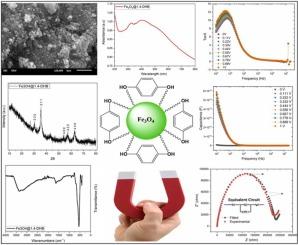Evaluation of the structural, morphological, magnetic, optical, and dielectric properties of a novel Fe3O4@1.4-DHB nanocomposites
IF 6.3
2区 材料科学
Q2 CHEMISTRY, PHYSICAL
引用次数: 0
Abstract
This study focuses on the detailed analysis of the synthesis, structural, morphological, surface textural, magnetic, optical, and electrical properties of Fe3O4@1,4-DHB magnetic nanocomposites (MNCs). Fe3O4@1,4-DHB MNCs were produced by a one-step chemical reaction process with a core-shell strategy. The average crystallite size, dislocation density, micro-strain, saturation magnetization, surface area and band gap energy values of Fe3O4@1,4-DHB MNCs were measured as 8.14 nm, 15.86×10-3 nm-2, 3.74×10-3, 41.96 emu/g, 101.96 m2/g and 4.38 eV, respectively. Fe3O4@1,4-DHB MNCs were determined to have an inverse spinel structure, exhibit superparamagnetic, and mesoporous characteristics. The narrow band gap of Fe3O4@1,4-DHB MNCs reveals that it has a wide light usage range and exhibits optical properties. The behaviors of the parameters Bode curve, dielectric constant, dielectric loss factor, loss tangent value, capacitance, admittance (susceptance, conductance), and real electric modulus, loss electric modulus of Fe3O4@1,4-DHB MNCs were investigated. The series resistance of Fe3O4@1,4-DHB MNCs was measured as 402 Ω, capacitance as 2.352×10-11 F, and charge transfer resistance as 227.3 kΩ. It was observed that increasing the frequency decreased the dielectric constant, dielectric loss factor, tanδ (after a certain value), and capacitance values. However, increasing the applied voltage (at low frequency) increased the phase angle, dielectric loss factor, tanδ values, capacitance values, and conductance values in a smooth regime. Because this nanocomposite exhibits magnetic, optical and dielectric properties, it can play an important role as a material that can be used in various applications in many branches of industry in the future.

一种新型Fe3O4@1.4-DHB纳米复合材料的结构、形态、磁性、光学和介电性能的评价
本研究重点对Fe3O4@1,4-DHB磁性纳米复合材料(MNCs)的合成、结构、形态、表面纹理、磁性、光学和电学性能进行了详细的分析。Fe3O4@1,4-DHB跨国公司是通过核-壳策略一步化学反应过程生产的。测得Fe3O4@1、4-DHB MNCs的平均晶粒尺寸、位错密度、微应变、饱和磁化强度、比表面积和带隙能分别为8.14 nm、15.86×10-3 nm-2、3.74×10-3、41.96 emu/g、101.96 m2/g和4.38 eV。Fe3O4@1,4-DHB MNCs具有反尖晶石结构,具有超顺磁性和介孔特征。Fe3O4@1,4-DHB MNCs的窄带隙表明其具有较宽的光使用范围和光学性能。研究了Fe3O4@1、4-DHB MNCs的波德曲线、介电常数、介电损耗因子、损耗正切值、电容、导纳(电纳、电导)、实电模量、损耗电模量等参数的行为。测量了Fe3O4@1,4-DHB MNCs的串联电阻为402 Ω,电容为2.352×10-11 F,电荷转移电阻为227.3 kΩ。观察到,增加频率会降低介电常数、介电损耗因子、tanδ(达到一定值后)和电容值。然而,增加施加电压(低频)会增加相角、介电损耗因子、tanδ值、电容值和电导值。由于这种纳米复合材料具有磁性、光学和介电性能,因此它可以作为一种材料在未来的许多工业分支中发挥重要作用。
本文章由计算机程序翻译,如有差异,请以英文原文为准。
求助全文
约1分钟内获得全文
求助全文
来源期刊

Journal of Alloys and Compounds
工程技术-材料科学:综合
CiteScore
11.10
自引率
14.50%
发文量
5146
审稿时长
67 days
期刊介绍:
The Journal of Alloys and Compounds is intended to serve as an international medium for the publication of work on solid materials comprising compounds as well as alloys. Its great strength lies in the diversity of discipline which it encompasses, drawing together results from materials science, solid-state chemistry and physics.
 求助内容:
求助内容: 应助结果提醒方式:
应助结果提醒方式:


